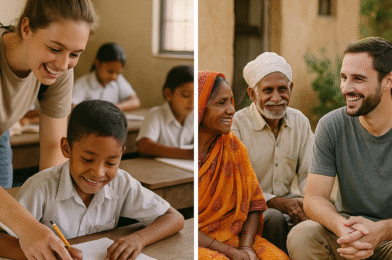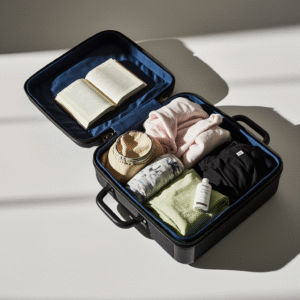You feel it—that persistent, quiet (or maybe not-so-quiet) call to go. It’s a desire to step out of your routine and join what God is doing around the world. But as you begin to explore this calling, one of the first and most significant questions you’ll face is: for how long?
The world of missions is vast, with opportunities ranging from a one-week project to a lifetime of service. The debate between the value of short-term and long-term mission trips is ongoing, but the truth is that one is not inherently better than the other. They simply serve different purposes and are designed for people in different seasons of life.
So, how do you discern your path? How do you know if you’re being called to a one-week immersion or a two-year commitment? This guide is designed to help you navigate that decision. We will break down the realities, benefits, and challenges of both short-term and long-term missions to help you prayerfully discover which one is right for you.
Understanding Short-Term Mission Trips (STM)
First, let’s define our terms. A short-term mission trip is generally any cross-cultural service experience that lasts from one week to a few months. These are the most common types of mission trips, often taking the form of a spring break trip for college students, a summer trip for a youth group, or a one-week project for a team from a local church.
The Pros: Why You Might Choose a Short-Term Trip
Short-term missions have exploded in popularity for several good reasons. They offer a unique and powerful way to engage with global work.
- Accessibility and Lower Commitment: This is the most obvious benefit. You can fit a one- or two-week trip into your existing vacation time or school breaks without having to quit your job or leave school. The financial and logistical commitment is significantly lower, making it a more attainable first step.
- Casting Vision and Igniting Passion: For many people, a short-term trip is the spark that ignites a lifelong passion for missions. It takes the idea of global needs from an abstract concept to a tangible reality. You meet the people, see the needs, and feel the presence of God in a new culture. This experience can transform how you pray, give, and live when you return home.
- Providing Specific, Targeted Support: When done well, STMs provide a massive boost to long-term workers on the ground. A team can come in and build a house, run a medical clinic, or execute a week-long children’s program in a fraction of the time it would take the local missionary. This offers a specific, valuable service that frees up long-term workers to focus on their relational ministry.
- Mobilizing Your Home Church: A team going out mobilizes the entire church to get involved. People who can’t go can give financially and, most importantly, commit to praying for the team and the community you’re serving. It connects your local congregation to the global Church in a powerful way.
The Cons: Potential Pitfalls to Consider
You must also be aware of the legitimate criticisms of short-term missions.
- Risk of Surface-Level Impact: Without a deep focus on partnership, an STM can be superficial. You risk developing a “savior complex,” thinking you can solve deep-seated problems in a week. True, lasting change takes time and relationship.
- Potential Burden on Hosts: A poorly planned or culturally insensitive team can be more work for the long-term missionaries on the ground than they are a help. They have to stop their regular ministry to host, translate for, and manage a team of visitors.
- Limited Cultural Immersion: In a week or two, you barely scratch the surface of a new culture. It’s nearly impossible to learn the language or understand the deep social nuances, which can lead to misunderstandings and missed opportunities.
A short-term trip might be right for you if: You are new to missions, want to support existing long-term work, have a specific skill to offer for a project, or can only commit a limited amount of time and resources.
Exploring Long-Term Mission Trips
A long-term mission trip typically refers to a commitment of one year or more. This is often what people think of as traditional “missionary work,” where you move to another country to immerse yourself in the language, culture, and community for an extended period.
The Pros: The Deep Impact of Staying
Committing to long-term service opens up possibilities that are simply not available in the short term. The depth of your impact and personal transformation can be immense.
- Deep Cultural Immersion and Language Learning: This is the greatest advantage. When you live in a community for years, you have the time to learn the language fluently. This allows you to move beyond surface-level conversations and build relationships based on genuine trust and understanding. You can hear people’s real stories and share your faith in a way that truly connects with their heart language.
- Greater Potential for Lasting Impact: Discipleship is not a one-week program. Lasting change, both in a community and in individual lives, is a slow, relational process. As a long-term missionary, you are there to walk with people through seasons of life, offering consistent support and mentorship.
- Increased Credibility and Trust: When you commit to staying, you cease to be a visitor and begin to become part of the community. Your neighbors see that you are sharing in their daily lives, their struggles, and their joys. This earns you a level of credibility that is essential for effective ministry.
- Profound Personal and Spiritual Transformation: Living long-term in another culture will stretch, break, and remake you in ways you cannot imagine. You will be forced to rely on God in a completely new way, confront your own cultural biases, and develop a resilience you never knew you had.
The Cons: The Realities of a Bigger Commitment
The rewards of long-term missions are high, but so are the costs.
- Significant Life Disruption: This is not a vacation. It involves leaving your job, your home, your friends, and your extended family. It’s a radical reorientation of your entire life.
- Extensive and Ongoing Fundraising: You aren’t just raising funds for a two-week trip; you are building a partnership team that will support you with prayer and finances on a monthly basis for years. This is a significant undertaking.
- Intense Loneliness and Culture Shock: While culture shock exists in the short term, it’s much more profound and prolonged when you stay. There will be seasons of intense loneliness, frustration, and feeling like a perpetual outsider.
- Higher Stakes and Burnout Risk: The emotional, spiritual, and physical toll of long-term cross-cultural work is immense. The risk of burnout is very real and requires a deep commitment to personal soul care and accountability.
A long-term trip might be right for you if: You feel a sustained call to a specific people or place, you have a passion for language and culture, your primary ministry desire is relational discipleship, and you are in a life stage that allows for such a significant commitment.
The Decision Framework: How to Choose Your Path
So, how do you decide? Here are five key questions to ask yourself prayerfully.
- What is Your Primary Goal? Are you looking for initial exposure to missions to see if it’s a fit? Or do you feel called to deep immersion and long-term discipleship? Your goal will point you in the right direction.
- What is Your Current Life Stage? Are you a college student with a summer break? A professional with two weeks of vacation? A recent retiree with newfound flexibility? Your current responsibilities and season of life will naturally make one option more feasible than the other.
- What is Your Capacity for Commitment? Be honest with yourself about your capacity for commitment—financially, emotionally, and spiritually. It is better to complete a short-term trip well than to commit to a long-term trip you are not prepared for.
- How are Your Skills and Gifts Best Suited? Do you have a technical skill (like construction or medicine) that is perfect for a short-term project? Or are your gifts more relational and pastoral, lending themselves to long-term mentorship?
- What Are the Workers on the Ground Asking For? This is crucial. Your decision should not be made in a vacuum. Research the needs in the places you’re considering. Listen to the long-term missionaries. Are they asking for short-term teams to help with a specific project, or are they praying for someone to come and commit to learning the language and co-laboring with them for years? Let the need guide your decision.
Don’t Forget the “Third Way”: Mid-Term Missions
It’s important to know there is also a growing category of “mid-term” missions, lasting anywhere from three months to a year. This can be a fantastic option, offering a deeper immersion than a short trip without the multi-year commitment of long-term service. It can serve as a perfect bridge to test the waters for a longer stay.
Ultimately, choosing between a short-term and long-term mission trip is a journey of discernment. One is not a “better” or “holier” choice than the other. Both are vital parts of God’s global work. The important thing is to faithfully and wisely follow the specific path He has laid out for you, in this season of your life.
Have you served on a short-term or long-term mission trip? What was your experience? Share your story or advice in the comments to help others on their journey!




 Why Packing Right Matters
Why Packing Right Matters